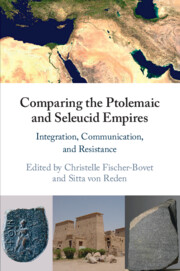Book contents
- Comparing the Ptolemaic and Seleucid Empires
- Comparing the Ptolemaic and Seleucid Empires
- Copyright page
- Contents
- Contributors
- Preface
- Note on Abbreviations
- Maps
- Introduction
- Part I Cities, Settlement and Integration
- Chapter 1 Imperial metropoleis and Foundation Myths
- Chapter 2 Reassessing Hellenistic Settlement Policies
- Chapter 3 The Integration of Indigenous Elites and the Development of poleis in the Ptolemaic and Seleucid Empires
- Chapter 4 Contextualizing a Ptolemaic Solution
- Part II Communication and Exchange
- Part III Collaboration, Crisis, and Resistance
- Bibliography
- Index
Chapter 3 - The Integration of Indigenous Elites and the Development of poleis in the Ptolemaic and Seleucid Empires
from Part I - Cities, Settlement and Integration
Published online by Cambridge University Press: 17 September 2021
- Comparing the Ptolemaic and Seleucid Empires
- Comparing the Ptolemaic and Seleucid Empires
- Copyright page
- Contents
- Contributors
- Preface
- Note on Abbreviations
- Maps
- Introduction
- Part I Cities, Settlement and Integration
- Chapter 1 Imperial metropoleis and Foundation Myths
- Chapter 2 Reassessing Hellenistic Settlement Policies
- Chapter 3 The Integration of Indigenous Elites and the Development of poleis in the Ptolemaic and Seleucid Empires
- Chapter 4 Contextualizing a Ptolemaic Solution
- Part II Communication and Exchange
- Part III Collaboration, Crisis, and Resistance
- Bibliography
- Index
Summary
This chapter focuses on Babylon and Egypt and offers a systematic comparison of the role of the local elites in the temple administration within the Seleucid and Ptolemaic governmental structures. While in both regions temples were the “centers of public life” before the Macedonian conquest, the traditional religious role of the king offered to the Ptolemies in Egyptian temples granted them a unique position that was not paralleled by the Seleucids in Babylonia. Moreover, the authors emphasize that the temple’s elite were representative of the local elite in Egypt, but that it was not the case in Babylonia. Therefore, these different traditions, notably the conception of the Egyptian king as a high priest superior to all the other priests, may explain why the administrative functions of the temples in Egypt, as well as the priestly elites, were largely integrated into the state structures of power, and why this did not happen in Babylonia. There, Seleucid kings could not play this role through the existing temple institutions and instead founded poleis as tools of governance of local communities.
Keywords
- Type
- Chapter
- Information
- Comparing the Ptolemaic and Seleucid EmpiresIntegration, Communication, and Resistance, pp. 86 - 105Publisher: Cambridge University PressPrint publication year: 2021
- 1
- Cited by



